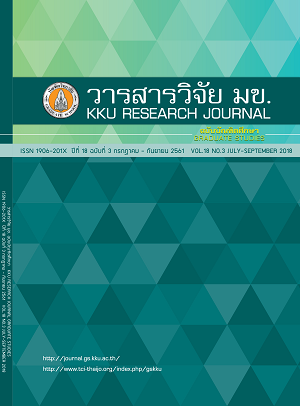The Effectiveness of Vegetable Washing Liquid on the Type of Pesticides and the Concentration of Formalin Residues in Vegetables
Keywords:
Pesticide, Formalin, Vegetable washing liquidAbstract
การศึกษานี้มีวัตถุประสงค์เพื่อเปรียบเทียบประสิทธิภาพของน้ำยาล้างผัก 3 ยี่ห้อในการลดชนิดของสารกำจัดศัตรูพืชและลดปริมาณฟอร์มาลีนที่ตกค้างในผัก 5 ชนิด คือ กะหล่ำปลี ถั่วฝักยาว มะเขือเปราะ โหระพา และพริกชี้ฟ้า จากตลาดสด 1 แห่ง และห้างสรรพสินค้า 1 แห่ง ในอำเภอเมือง จังหวัดสุราษฎร์ธานี ผลการศึกษาพบว่า ผักทั้ง 5 ชนิด พบสารกำจัดศัตรูพืชตกค้างในกลุ่มออร์กาโนฟอสเฟสและคาร์บาเมท ชนิด cabofuran, carbaryl และ chlorfenvinphos และกลุ่มออร์กาโนคลอรีนและไพรีทรอยด์ ชนิด endrin, DDT และ endrosulfan นอกจากนี้ยังตรวจพบฟอร์มาลีนตกค้างในผักทั้ง 5 ชนิด ซึ่งมะเขือเปราะมีปริมาณฟอร์มาลีนตกค้างมากที่สุด ทั้งนี้ผักทั้ง 5 ชนิดจากตลาดสดและห้างสรรพสินค้ามีปริมาณฟอร์มาลีนตกค้างในผักไม่แตกต่างกันอย่างมีนัยสำคัญทางสถิติ (P<0.05) น้ำยาล้างผักที่มีขายทั้ง 3 ยี่ห้อไม่สามารถล้างสารกำจัดศัตรูพืชและฟอร์มาลีนที่ตกค้างในผักได้หมด โดยน้ำยาล้างผักยี่ห้อที่ 1 และ 2 สามารถล้างสารกำจัดศัตรูพืชกลุ่มออร์กาโนฟอสเฟส คือ cabofuran ส่วนน้ำยาล้างผักยี่ห้อที่ 3 สามารถล้างกลุ่มออร์กาโนฟอสเฟสและคาร์บาเมท คือ chlorfenvinphos และ carbaryl ซึ่งน้ำยาล้างผักทั้ง 3 ยี่ห้อ ไม่สามารถล้างสารกำจัดศัตรูพืชกลุ่มออร์กาโนคลอรีนได้ เนื่องจากสารในกลุ่มนี้มีความคงทนสูงและสลายตัวช้า และผักที่ผ่านการล้างด้วยน้ำยาล้างผักยี่ห้อที่ 1, 2 และ 3 มีปริมาณฟอร์มาลีนลดลงได้สูงสุด 20%, 21% และ 24% ตามลำดับ ดังนั้นผู้บริโภคควรเลือกใช้น้ำยาล้างผักให้เหมาะสมกับชนิดของผัก นอกจากนี้เจ้าหน้าที่ภาครัฐและผู้ที่เกี่ยวข้องกับการคุ้มครองผู้บริโภคควรเฝ้าระวังสารกำจัดศัตรูพืชและฟอร์มาลีนตกค้างในผักให้อยู่ในระดับที่ปลอดภัยต่อผู้บริโภค
References
Analytical Chemistry. 2011; 30 (6): 814-826.
2. Lozowicka B, Kaczynski P, Rutkowska E, Jankowska M, Hrynko I. Evaluation of pesticide residues in fruit from
Poland and health risk assessment. Agricultural Sciences. 2013; 4 (5): 106-111.
3. Shafi M, Imran M, Sarwar M, Kalsoom S, Mujahid H. A Study of Pesticide residues in different fruits collected
from different fruit markets of Lahore, Punjab. Journal of Agroalimentary Processes and Technologies.
2014; 20 (4): 298-303.
4. Poophalee T, Wongwattanasathien O, Arparsrithongsakul S, Supuntee M. Prevalence of pesticide residues in
vegetables from markets and supermarkets in Muang District, Maha Sarakham Province. Thai Journal of
Pharmacy Practice. 2016; 8 (2): 399-409. Thai
5. Jaman N, Hoque S, Chakraborty S, Hoq E, Seal H. Determination of formaldehyde content by spectrophotometric
method in some fresh water and marine fishes of Bangladesh. International Journal of Fisheries and
Aquatic Studies. 2015; 2 (6): 94-98.
6. Joshi R, Bhatta R, Paudel P, Kafle B. Formaldehyde content of selected fish from the wet markets of Kathmandu
valley. International Food Research Journal. 2015; 22(4): 1434-1437.
7. IARC. Formaldehyde, 2-butoxyethanol and 1-tert-butoxypropan-2-ol. Momographs on the evaluation of
carcinogenic risks to humans. 2006. Vol.88.
8. Hauptmann M, Lubin J, Stewart P, Hayes R, Blair A. Mortality from lymphohematopoietic malignancies among
workers in formaldehyde industries. Journal of the National Cancer Institute. 2003; 95: 1615-1623.
9. Pinkerton L, Hein M, Stayner L. Mortality among a cohort of garment worker exposed to formaldehyde: An
update. Occupational & Environmental Medicine. 2004; 61: 193-200.
10. Cogliano V, Grosse Y, Baan R, Straif K, Secretan M, El Ghissassi F. Meeting report: summary of IARC
monographs on formaldehyde, 2-butoxyethanol, and 1-tert-butoxy-2-propornal. Environmental Health
Perspectives. 2005; 113: 1205-1208.
11. McGregor D, Bolt H, Cogliano V, Richter-Reichhelm H. Formaldehyde and glutaraldehyde and nasal
cytotoxicity: case study within the context of the 2006 IPCS human framework for the
analysis of a cancer mode of action for humans. Critical Reviews in Toxicology. 2006; 36: 821-835.
12. Costa S, Coelho P, Costa C, Silva S, Mayan O, Santos L, et al. Genotoxic damage in pathology anatomy
laboratory workers exposed to formaldehyde. Toxicology. 2008; 252: 40-48.
13. Beane F, Blair A, Lubin J, Stewart P, Hayes R, Hoover R, et al. Mortality from lymphohematopoietic
malignancies among workers in formaldehyde industries: The National Cancer Institute cohort. Journal of
the National Cancer Institute. 2009; 101: 751-761.
14. Environmental Protection Agency: EPA. Exposure Factors Handbook. Nation Center Environmental Assessment
Office of Research and Development. 2007; 5: 1-3.
15. Suwanaruang T. Formalin contamination in fruits and vegetables at kalasin fresh market, Thailand. In Proceeding
Prachachuen Research Network International Conference. Bankok. 2015; 370-373.
16. Wanwimolruk S, Kanchanamayoon O, Phopin K, Prachayasittikul V. Food safety in Thailand 1: Pesticide
residues found in Chinese kale (Brassica oleracea), a commonly consumed vegetable in asian countries.
Elsevier Editorial System(tm) for Science of the Total Environment. 2015.
17. Sangchom S. Situation and Health Effects Related to Pesticides, 2013. Weekly Epidemiological Surveillance
Report. 2013; 44 (44): 689-701. Thai.
18. Pornsiripratarn S. Exporting Thai fresh vegetables and fruits to Europe. International Institute for Trade and
Development. 2013. 1-21. Thai.
19. Nash T. The colorimetric estimation of formaldehyde by means of the Hantzsch reaction. Biochemical Journal.
1953; 55: 416-421.
20. Bajwa U, Sandhu K. Effects of handling and processing on pesticide residues in food-a review. Journa l of Food
Science and Technology. 2014; 51 (2): 201-220.
21. Taweeporn S. Development of produce wash for removal of residual insecticides from mandarin cv. Sai Nam
Pung. Master of Science (Postharvest Technology) Postharvest Technology Institute, Chiang
Mai University. 2006. 93 pages. Thai.
22. Koranee R, Prangsurang P. The study comparing the effectiveness of washing method to eliminate pesticide
residues in fresh vegetables. FDA journal. 2016; January-April: 34-42. Thai.


